Fuji X-E1 – upsized compared to Nikon D800E (Iridient) + best postprocessing in Windows
image courtesy: soundimageplus
Here again, talking about Iridient Developer. The last time, after processing his images with iridient, soundimageplus wrote that “I’m not saying that upsized Fuji X-E1 or Leica X Vario upsized files are as good as native D800E files, they are not, but they are pretty damn close. Close enough in fact to suggest that I would be better off selling the Nikons and concentrating on the Fuji X system.”
Now, how close can the X-Trans files come to the [shoplink 14519]D800E[/shoplink] files (read it here)?
“With some careful processing and post-processing I could probably get the two even closer, but this will show just what the X-Trans sensor is capable of once its files are processed in a software package that attempts to do them justice. […] the test is primarily for me to see if a Fuji X camera can ‘replace’ the Nikon D800E for my purposes. I must repeat again I’m not saying the Fuji is even the equal of the Nikon in terms of image quality at this size, it isn’t, but its probably close enough for virtually any commercial use, as far as I’m concerned and this test encourages me to try some other combinations out to see just what I can achieve.”
For those wondering how Iridient works with high ISO, check this soundimageplus post here. “I’m once again impressed.”
Last but not least, soundimageplus shared also his Iridient Developer workflow here.
_ _ _
If you do not own a Mac and therefore can’t use Iridient, here is the “Best practice postprocessing X-trans files in Windows” sent to me by FR-reader Per K (thanks for sharing with FR):
“Hi Patrick
I made a comment on your Irident thing with reference to Soundimageplus. The later asked for more information about my process. Thought the best way to share was via Fujirumors.
My first intention was to compare the performance of my Nikon MF 200/4 [ebay worldwide via slidoo] on X-E1 vs Nikon D800. Purpose was also to verify that the adapter was OK.
Setup: A huge rockwall close to me. Cameras, lens and a sturdy tripod. Distance to subject about 80m. The D800 was set to DX (APS-C) sensor crop = NO downsampling. Almost as many Mpix as on the Fuji.
Fuji test images were postprocessed using Capture One Express and Lightroom 5. Nikon testimages in Lightroom 5 only.
Process
C1: Sharpness 192, 0.2, 0.3. Noice reduction (color and luminance) set to 0. No other adjustments. Export as TIF 24bit ProPhoto RGB.
Lr5: Import of TIF files. Normal post processing.
Comments:
C1 RAW converter produces nice, punchy images. It has some powerful tools that may create atrifacts and halos. When X-trans files are imported directly to Lr5 they cannot take much sharpening beforr the image falls apart. After the pre-post process in C1 there is no such problem. The file reacts to sharpening in the same way as D800 or [shoplink 13127]Sony RX100[/shoplink] files.
I do not understand why C1 is set to heavy noise reduction (50 on a scale 0 – 100) in the standard setting! Setting it to 0 makes a clear, positive difference in sharpness and detail. My take on noise reduction is to use it only when you absolutely need it. Sharpness, detail and looking natural is important in most of my images.
Results:
Examining files from both cameras shows: a) The 200/4 performs equally well on both cameras. b) At 100% the Nikon file is only just a little sharper and smoother. Difference will not show on an A3 print. (The [shoplink 14518]Nikon D800[/shoplink] “Image quality engine” is currently state-of-the-art i guess meaning that X-E1 post processed this way is very close. This makes me happy! I have two excellent cameras, like both a lot, usability and image quality. They are different though and serves different purposes.
About “Image quality engine”: Many believe it is all about the sensor, but that is very wrong! Other electronics are as important and the most important factor is the programming. Remeber that Bayer sensor based solutions have been developed for more than a decade by the strongest in photo industry. X-trans concept is very new and only developed by Fuji, one of the smaller players. I expect that X-trans will evolve and further improve image quality over the coming years.
Here is a link to images made with postprocessing in C1 and Lr5. Some are heavily cropped.
http://perkylberg.smugmug.com/Street-Scenes/A-trip-to-the-city-centre/30551330_xfrR48#!i=2636083621&k=vqVJVnB
BR Per K
image courtesy: Per K



